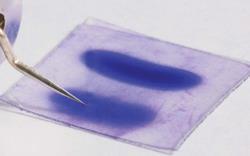A new approach to nanoscale analysis of the elements in biological samples and gels has been developed by scientists in Germany
A new approach to nanoscale analysis of the elements in biological samples and gels has been developed by scientists in Germany.

Sabine Becker and colleagues used near-field laser ablation inductively coupled plasma mass spectrometry to measure uranium, copper and zinc in 2D gels, rose petals and African violet leaves.
Until now, microscopic techniques of this type have lacked the ability to assess elemental composition. Becker’s approach can analyse single cells and cell organelles such as mitochondria. The method also has the potential to be used for studying isotope variation in natural samples.
Future developments are required to allow medical and biological application in the life sciences. According to Becker the technique has potential for the analysis of metal distribution in tissues, single cells, cell organelles or extracellular plaques, and to study neurodegenerative diseases such as Alzheimer’s Disease. This technique may also have applications in materials science, nanotechnology and nanoelectronics.
Robin J Forder
References
J S Becker, A Gorbunoff, M Zoriy, A Izmer and M Kayser, J. Anal. At. Spectrom., (DOI: 10.1039/<MAN>b514401a</MAN>)






No comments yet